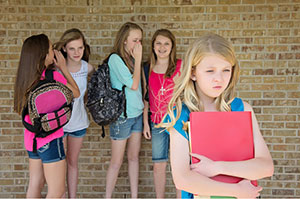Females use different tactics but still hurt victims.
By Cary and Tonja Rector.
Bullying among kids has gained national attention and schools now have programs to recognize and address it right away. Parents are more aware of the issue, and what was once considered a rite of passage during childhood is getting a reappraisal.
The word “bully” lends itself to an image of a boy who is larger than his peers and uses physical coercion and threats to get what he wants. Bullying among girls can look quite different; they more often use emotional bullying or relationship bullying as a tactic. It includes exclusion, social rejection, humiliation and spreading rumors. This type of bullying is just as harmful as physical aggression.
Bullying among girls is often covert, vicious and difficult for adults to detect. Is that group of girls hanging out by the school building simply talking or is one the target of whispers and giggling? The use of social media to bully makes it even more difficult for adults to observe interactions and intervene when needed. Here are some details on girls and bullying, including tips for parents.
Relationship bullying is powerful and difficult to detect. According to Barbara Coloroso, author of The Bully, the Bullied and the Bystander (William Morrow; 2009), relational bullying involves the systematic diminishment of a child’s sense of self through isolation and exclusion. When exclusion is paired with rumor, a potent bullying tool is in play. Subtle social interactions are used to bully, such as eye rolling, whispering, aggressive stares, sneers or laughing.
Girls bully in packs. One of the hallmarks of girl bullying is the process of recruiting others to gang up on the victim. The victim is ostracized, ridiculed and shunned by the group for no real reason. This tactic is used to gain control and social power. Kids within the group often go along out of fear of being the next target.
Bullying can start early. Be aware of social interactions among children in early elementary school. During these years, it is easier for adults to intervene and redirect the social dynamic. Remember to support girls not directly involved in the bullying behavior. Encourage them to not go along with something that doesn’t feel right. Teach children early to stand up for others who are being treated cruelly. A kind word or supportive statement can make all the difference.
Adults often don’t recognize girl bullying. Research shows bullying among girls peaks in middle school. Bullying behavior can be dismissed as “normal” for the age group or as a rite of passage with no reason for adult concern. By contrast, if your child were the target of physical aggression on a daily basis, most parents would immediately get involved. Treat emotional bullying with the same concern. Listen and offer support to your daughter. Don’t insist she “work it out” with the girls involved. Would you expect her to remain friends with someone who was physically aggressive?
Girl bullies may use different tactics than boys, but the goals are the same—to intimidate and control. Bullies use an imbalance of social power to hurt and threaten their victims. An imbalance of power can result from the bully being older or higher on the social ladder, or from a group of kids forming an alliance for the purpose of bullying. Bullies expect their actions to hurt, and their behavior is intentional. Bullying is not a one-time event resulting from a conflict or anger over a specific incident. Both bully and target expect it to happen again.
Recognizing the ways in which girls bully can help parents and other adults address the situation. It is not “normal” social interaction to isolate, shun or humiliate a peer at any age. With greater awareness and adult guidance, all forms of bullying can be decreased.


